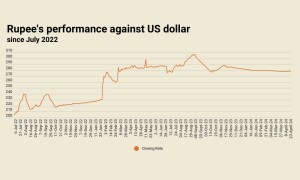SHANGHAI: China’s yuan finished the domestic trading session at a near 28-month low on Friday and looked set for its biggest weekly loss in five months, as a widening yield differential between the world’s two largest economies continued to weigh on the Chinese currency.
The US dollar strengthened in global markets, with benchmark US Treasury yields hitting an 11-year high overnight, as investors positioned for more Federal Reserve interest rate hikes to tame high inflation after its latest hike this week.
In the spot market, the onshore yuan weakened past the key 7.1 per dollar to finish the domestic session at 7.1104 per dollar, the weakest such close since June 4, 2020. It was 314 pips, or 0.44%, softer than the previous late night close of 7.0790.
If the onshore yuan finishes the late night session at the domestic closing level, it would book its sixth straight weekly loss, dropping about 2% to the dollar.
Its offshore counterpart fell to 7.1191 per dollar around 0830 GMT.
“The growth differential as well as the Fed-PBOC divergence could continue to keep the USD/CNH on the upswing,” analysts at Maybank said in a note.
The yield gap between the benchmark 10-year US Treasury bond and its Chinese counterpart hovered at the widest level since 2007.
China, along with Japan, are major outliers in a global run of interest rate hikes, but the widening policy divergence has hurt their currencies.
Prior to the market opening, the People’s Bank of China (PBOC) set the midpoint rate at 6.9920 per dollar, 122 pips or 0.17% weaker than the previous fix 6.9798, the weakest since Aug. 3, 2020.
But the central bank continued to set the official guidance rate firmer than market projections for the 22nd straight trading day, a move that market interpreted as an effort to slow the yuan’s slide. Friday’s midpoint was 160 pips stronger than Reuters’ estimate of 7.0080.
Some market participants said the central bank’s firmer-than-expected midpoint fixings have limited the downside room, as the onshore yuan is only allowed to trade in a narrow range of 2% around the daily guidance.
Friday’s fixing level would allow a trading range of between 6.8522 and 7.1318.
Traders said investors continued to digest a string of global central bank decisions to raise interest rates following the Fed’s aggressive 75-basis-point hike on Wednesday.
Citi analysts said in a note that market tended to be cautious about a counter-cyclical policy response from authorities as importers’ FX conversion ratio continued to rise. It sees the yuan weakening to 7.2 per dollar.
An ex-PBOC adviser told Reuters that the yuan remains relatively strong against other non-dollar currencies, and a weakening yuan has both pros and cons for the economy.
“China has more economic problems at the moment. The domestic economic growth rate is not satisfying, but China’s balance of payments, especially the trade situations, remains sound,” he said.
“As long as we continue to adhere to a flexible exchange rate mechanism and maintain moderate management of cross-border capital flows, the yuan’s basic stability can be maintained.” The yuan has lost more than 10% of its value against the dollar so far this year, but against currencies of China’s major trading partners it has fallen just 0.86%.
























Comments
Comments are closed.